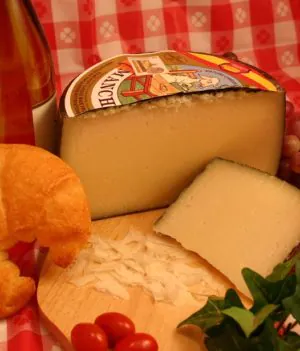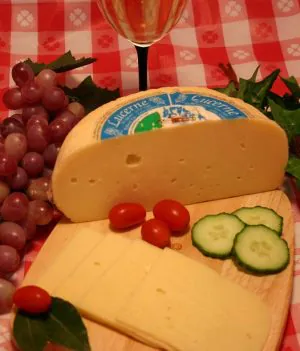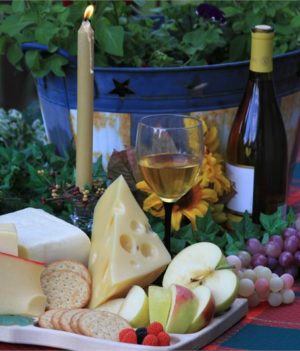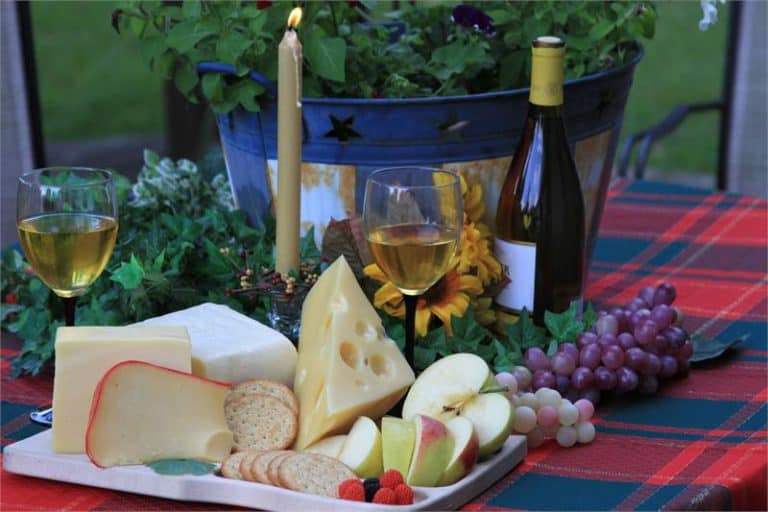Blog
Cheese Glossary: The Letter S
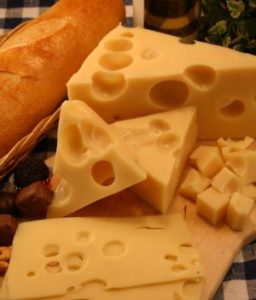
Salting
The process of adding salt to cheese! Salt can be added when the cheese is still in curd form or it can be rubbed on after the cheese is pressed, depending on which cheese it is. A salt solution can also be used. This is known as brining. Whilst some of the flavor of cheese is achieved through salting, the process also preserves the cheese.
Semi-hard
Cheeses vary from hard to soft based on their body and texture. Cheddar and Swiss are examples of semi-hard cheeses.
Semi-soft
Semi-soft cheeses are usually made from whole milk and melt when heated.
Sharp
A flavor term referring to the fully developed flavor of aged cheeses. Cheeses that might be sharp include Cheddar, Provolone and blue-veined cheeses like Danish Blue.
Smoked
Smoked cheese is produced in a similar way to smoked meats. There are various ways to do this including adding smoking over wood or adding liquid smoke to brine. We stock a wide variety of smoked cheeses.
Soft
Cheeses with a high moisture content. They are usually set with the addition of lactic acid cultures and include cheeses such as cottage cheese, mascarpone, and ricotta.
Soft-ripened
These cheeses, such as Brie and Camembert, have a thin white or cream rind that is soft and edible. They are usually soft inside and have a luscious, creamy texture.
Stabilizer
An ingredient added to products, including cheese, to improve consistency and texture.
Starter
A culture that normally has varying percentages of lactic acid, bacteria or mold spores, enzymes or other microorganisms and natural chemicals. Starter cultures control the process of curdling milk during cheesemaking by converting lactose to lactic acid. They can also give the cheese particular flavor and characteristics.
Stirred-curd Cheese
These are sometimes called granular cheeses. They are made in a similar way to cheddar cheese but do not go through the cheddaring and milling process. It tends to have a higher moisture level than other cheeses. The granular aspect comes from the open look to the
cheese.
Stretched
Cheeses that have stretched curds are kneaded with hot water, which gives them a fibrous structure. The most common example would be mozzarella.
Surface-ripened
Cheeses that ripen from the outside in when a mold, yeast or bacteria is applied to the surface.
Swiss
A holey, semi-hard cheese with a creamy color, Swiss cheese has a nutty, slightly piquant flavor whilst simultaneously being somewhat creamy. The process of making Swiss cheese involves natural bacteria consuming the lactic acid in the cheese. This releases carbon dioxide gas, which forms bubbles that become the holes in the cheese. These are often referred to as “eyes”.
We hope that you continue to enjoy our cheese glossary!
Show Your Support This Veteran’s Day
As today is Veteran’s Day and we are passionate supports of our veterans, we wanted to share our Veteran’s Day Care Package with you.
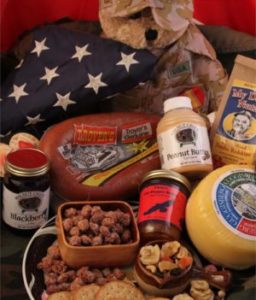
This is a great way to remind our heroes that we still appreciate all they do! It is perfect as a gift for our veterans or as active duty military care packages. We have included less perishable options than some of our other gift boxes, for those who wish to send a care package to military personnel stationed overseas.
There really is nothing like a little taste of home to let our men and women in uniform know they are appreciated. We will ship to any FPO-AP address via U.S. Postal service. We will also show our appreciation for our men and women in uniform by donating a portion of the proceeds from every package sold to The Wounded Warrior Project.
The Veteran’s Day Care Package Includes:
- Baby Swiss Cheese Wheel (2 Lbs.)
- Trail Bologna Ring or Beef Jerky (In non-perishable option)
- Clem’s Hot Pepper Relish – delicious with cheese and crackers!
- Banana Split Mix – cranberries, banana chips, almonds, chocolate covered peanuts, chocolate drops, pineapple tidbits, raisins, yogurt covered peanuts, peanuts, and yogurt drops all mixed together for a great trail mix
- Amish Peanut Butter Spread
- Amish Homestyle Jam
- Carr’s Crackers
We know that you love to show your appreciation and, to us, food is the perfect way to do that.
Here at Shisler’s Cheese House, we also make a range of gift boxes if the Veteran’s Care Package isn’t quite right for you.
Our Football Season Special is perfect for sports lovers. It contains Swiss Cheese, Troyer’s Trail Bologna, Pepper Jack Cheese, Shisler’s Private Label Mustard, Shisler’s Private Label Hot Pepper Relish, and Carr’s Crackers.
The Fall Harvest Collection celebrates the best flavors of fall in Amish Country. You’ll find Baby Swiss Cheese (2 Lbs.), Streb Meats Smoked Sausage (1 Lb.), Cranberry Delight (1 Lb.), Pumpkin Muffin Mix, Pumpkin Butter, and Popcorn on the Cob inside.
If you want to show your support to a beer and cheese lover, then our Beer Collection is absolutely the gift for you. It contains enough Brick, Gouda, Gruyere, and Ohio Premium Swiss Cheese to entertain 20 people. These cheeses have been chosen for their strong flavors which pair beautifully with beer. We recommend trying out a few different beers to compare the tasting experience.
Finally, our Hot Stuff Collection has everything that you might need for someone who lives spice and heat. Enjoy trying Hot Pepper Cheese, Habanero Cheese, Troyer’s Trail Bologna with Hot Pepper Cheese, Shisler’s Private Label Hot Pepper Relish, Shisler’s Private Label Hot Jalapeno Mustard, Hot Pepper Jelly, and Carr’s Crackers. Be warned, you might need a cooling glass of milk on hand.
Do get in touch if you have any questions about any of our gift boxes, but especially if you would like to get a Veteran’s Day care package for a special someone to recognise their service this month.
We’d also love for you to take a look at the work of the Wounded Warrior Project and consider supporting them in their efforts.
Cheese Glossary: The Letters Q and R
A treat for you today: two letters from our cheese glossary!
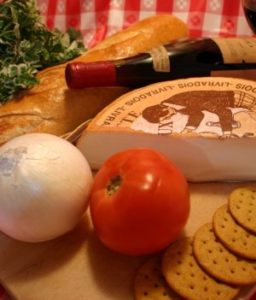
Quarter Wheel
A quarter of a 20-pound wheel of cheese.
Queso
The Spanish word for cheese.
Raclette
Raclette (ra-klet) is a semi-firm, salted cheese made from cow’s milk. It originated in the Swiss canton of Valais, but is today also produced in the French regions of Savoie and Franche-Comté. The term raclette derives from the French racler, meaning “to scrape”. Raclette cheese is heated, either in front of a fire or by a special machine, then scraped onto diners’ plates.
Raclette is mentioned in medieval writings and was then known in the German-speaking part of Switzerland as Bratchäs, or “roasted cheese.” Traditionally, the Swiss cow herders used to take the cheese with them into the mountains. They would cook it by the campfire and scrape it onto bread. Now, electric table-top grills with small pans make the job of melting the cheese easy and fun. Each guest fills their small pan, known as a coupelles, with cheese and melts it before adding it to their plate.
Raw milk
This is simply the term for milk that has not undergone pasteurization.
Rennet
This comes from the membranes of calves’ stomachs and contains rennin, an enzyme. This aids in coagulating milk or separating curds from whey. There are also vegetarian forms of rennet that can be commercially produced from fungi.
Rind
The outer surface of the cheese. Rind can vary from soft to hard as well as in thickness and color. Natural rinds exist but some are produced from a harmless mold.
Rindless
Cheese without a rind. Some of these are not ripened so they won’t develop a rind and others are protected with a coating or plastic film.
Ripening
The aging process that cheese goes through.
Rustic
A term for cheeses that are earthy in flavor and aroma.
Cheese Glossary: The Letter P
Today we are continuing with our cheese glossary! Ever wondered what cheese that starts with a p? Learn now!
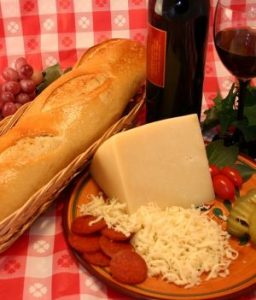
Parmesan
Parmesan Cheese is a hard, dry cheese, which has a complex, sharp, nutty flavor and a somewhat grainy texture. It is made from unpasteurized cow’s milk. Starter whey, containing thermophilic lactic acid bacteria, and rennet is added to separate the curds. These are then compacted and placed into molds. The wheels are placed into brine baths for up to 25 days where they absorb the salt. After brining, each cheese is aged for 12 months.
Parmigiano Reggiano
Parmigiano Reggiano cheese gets its name from the Italian regions of production: Parma, Reggio Emilia, Modena, Bologna, and Mantova. It originated in the Middle Ages, at least 700 years ago. It was first made by monks in Reggio Emilia, with production spreading to the Parma and Modena regions. With the exception of new production equipment and technology, the basic process to make the cheese has changed very little in the hundreds of years since.
A Parmesan Consortium was created in 1934 which regulates the production of authentic Parmesan Cheese and inspects all of the cheese produced by nearly 800 cheese producers. Parmigiano Reggiano is a Protected Designation of Origin (PDO) cheese in the European Union, which legally requires the cheese to be produced in certain regions of northern Italy in order to be labeled as Parmigiano Reggiano. Outside of Europe, the phrase “Parmesan Cheese” may be used to refer to any hard grating cheese.
Pasteurization
A process of treating food or drinks with mild heat to extend their shelf life.
Penicillium
A group of molds is used in various processes including food production.
Penicillium Camemberti
A white mold that is used to make Camembert, Brie, Langres, Coulommiers, and Cambozola cheeses.
Penicillium Glaucum
A mold that is used to make cheeses including Gorgonzola.
Penicillium Roqueforti
A mold used in the production of Roquefort, Gorgonzola, Stilton, and Danish Blue.
Pressed
A cheese there the curd is placed in a mold and pressed to form the shape of the finished cheese.
Provolone
Provolone Cheese, like mozzarella, is a pulled or stretched curd cheese with two varieties. Dolce (mild Provolone) is aged for just two to three months. It is a semi-soft, mild, smooth table cheese. Piccante is aged for six to twelve months and has a much stronger flavor.
The term Provolone (meaning large provola) appeared around the end of the 19th century when it started to be manufactured in the southern regions of Italy. Modern Provolone has smooth skin and is produced mainly in the regions of Lombardia and Veneto. It is produced in different shapes. Some are like a very large sausage which may be up to 30 cm (1 ft) in diameter and 90 cm (3 ft) long, whilst others come in a truncated bottle shape or a large pear shape which has a characteristic round knob for hanging.
Provolone cheese can be made with buffalo or cow’s milk, or a mixture of the two. Once the curds and whey have been separated, the curd is kneaded and stretched while still hot. The cheese is bathed in brine before a wax or plastic rind is added to the outside. It is tied up with rope and hung in the aging cellar.
Proteolysis
This is the process of casein protein breaking down into other compounds including peptides and amino acids, that give cheese flavor.
Pungent
This describes a particularly sharp aroma of cheese.
Happy Halloween from us!
Happy Halloween to all of our wonderfully ghostly customers! We hope you have a very spooky day indeed. We’ve put together a few of our favorite ideas for making Halloween fun.
1. Carving Pumpkins
Of course, pumpkin carving is the classic decoration for Halloween. We absolutely love to make our own designs! Traditional faces are easy to carve, but there are so many online tutorials that can help you to create intricate designs that are sure to impress trick or treaters! Do remember to be careful of any open flames when the pumpkins are lit and to keep the pumpkins away from places where people could injure themselves.
Make sure that you don’t waste the actual pumpkin flesh. It’s delicious roasted as a side dish or cooked into a warming soup for cold evenings. Try using a cookie cutter to cut bread shapes such as ghosts or bats for a fun addition to your soup. You can even roast the seeds with different flavors like salt, chilli, or caramel for a quick crunchy snack. Why not try a pumpkin mac and cheese to warm you up?
2. Spooky Baking
We love to get into the kitchen and create something delicious for Halloween!
Spider Cookies
This recipe is lots of fun to make. Get the whole family involved to create a fantastic treat. Use your favorite cookie recipe or even pre-bought dough to make a big batch of cookies. Melt white chocolate and use it to pipe a web onto the cookies. The easiest way to do this is to pipe on concentric circles and then use a cocktail stick to pull the circles into a web shape. Leave this to set. Then melt milk chocolate and pipe on your creepy spiders. You could even add icing eyes or create your own using candy.
Witch’s Hats
Cut puff pastry or pre-made crescent rolls into the shape of witch’s hats. Decorate with a strip of Colby cheese as a ribbon. You could even use sweet or savory filling to make them into pies. Try pumpkin, cream cheese or melted chocolate for fun seasonal flavors.
3. Decorations
If you want to make sure that trick or treaters visit you, then some decorations will send the message that you are happy to meet them. Of course, your pumpkins will light the way but there are some other ways that you can decorate your home.
Floating witch’s hats
Use fishing line to hang witch’s hats in your porch for a fun decoration that can be seen by your neighbors. You could even use battery powered fairy lights or glow sticks to make them light up so that they can be seen at night. Make sure that they are hung up high so that no-one walks into them!
A Halloween tree
You can now find artificial Christmas trees in a huge range of colors, including black and white. Pick one of these up and decorate it as a Halloween tree. There are lots of spooky ornaments available in the shops and online. Add some cobwebs, skulls, and spiders for a truly creepy tree. You can even get orange tinsel or pull out any dark colored Christmas decorations to add some extra sparkle.
How are you celebrating Halloween? Let us know in the comments below! Have a spooky day!
Cheese Glossary: The Letters N and O
We return to our cheese glossary for the letters N and O!

Natural
A general term for cheese that has been made directly from milk, whether it is pasteurized or unpasteurized. It can also refer to the cheesemaking process itself of coagulating or curdling the
milk, stirring and heating the curd, draining the whey and collecting or pressing the curd.
Natural Rind
A rind that forms naturally on cheese whilst it is drying and ripening. Ripening agents or washing are not used to create the natural rind. Most semi-hard and hard cheeses will have this, including Parmesan and Romano Pecorino.
Nutty
Cheeses with a nut-like flavor, such as Swiss cheeses.
Oily
This can describe the body, flavor or aroma of a cheese.
Open
A term applied to cheese varieties containing small holes that develop during the manufacturing process. These holes may be small or large, densely patterned or randomly scattered, and irregular in shape. Air might be introduced through punctures made with steel pins, such as in the production of blue-veined cheeses. These pin holes are not the same as the open ‘eyes’ that form during fermentation of cheeses such as Swiss cheese.
Organic
Grown without the use of chemical pesticides or fertilizers.
Overripe
A cheese that has gone past its best. It has likely become too soft.
Ovolini
A ball of fresh mozzarella, weighing approximately four ounces.
Oxidation
This can cause cheese to become bleached or dry, depending on how it has been packaged.
We have come to the halfway point of our cheese glossary and we are really enjoying teaching you all about the different terms associated with cheese. We hope it is helping you to learn more about the cheeses that you love. What would you like to learn about next? Let us know in the comments below and we will make it the focus of our next set of posts!
Cheese Glossary: The Letter M
Another letter for our cheese glossary today!
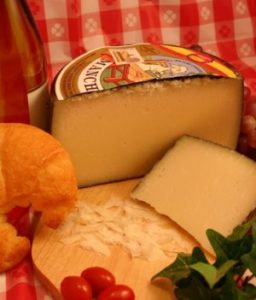
Manchego
Manchego is a sheep’s milk cheese from Spain. The shape of Manchego cheese is very characteristic and defined. It has an intense taste and crumbly texture which makes it perfect for eating alone. It has a rich golden color and small holes. It is traditionally made with grass molds so it has a very distinctive zigzag pattern on the cheese. It appears as a herringbone pattern n the rind, which is inedible.
The rich, semi-firm product is aged in natural caves for two to six months, giving it a zest and exuberant flavor. It is always aged for a minimum of two months. There are significant changes in the flavor over time and sometimes in Spain, you will see it served in a variety of ages.
Manchego cheese is made in the La Mancha region of Spain. It has a long historical and literary tradition, as it was mentioned by Cervantes in the legendary “Don Quixote of La Mancha”.
It is made from the whole milk of the Manchega sheep, which are only bred in the La Mancha region. Archaeological remains show that a cheese like Manchego may have been made as far back as the Bronze Age.
Marbled
Marbled cheese is usually a blend of Monterey Jack and Colby cheese, marbled together to create a striking effect. Monterey Jack is a buttery, semi-firm cheese that originated in California. It is usually only aged for around a month, making it a fresh, fairly soft cheese to enjoy.
Medium-aged
A semi-hard or hard cheese that has usually been aged for three to six months.
Mozzarella
Mozzarella is a semi-soft cheese. Due to its high moisture content, it is traditionally served the day after it is made, but can be kept in brine for up to a week or longer when sold in vacuum-sealed packages.
Derived from the Neapolitan dialect spoken in Campania, mozzarella is the diminutive form of mozza (“cut”) or mozzare (“to cut off”) derived from the method of working. The term is first mentioned in 1570, cited in a cookbook by Bartolomeo Scappi, reading “milk cream, fresh butter, ricotta cheese, fresh Mozzarella, and milk”.
Citric acid and milk are combined and then heated until the mixture is ready to have rennet added. At this point, the curds and whey will have separated and the curds will be cut. They are the removed, stretched and kneaded until they become the cheese that we recognize.
Muenster
Muenster cheese is a mild, white cheese with a reddish-orange rind made from paprika. This can be eaten but is often cut off. It is semi-firm in texture with a mild smell that stronger as it ages. Muenster cheese is currently made in Germany, France, and the United States. It was originally made by Benedictine monks that migrated to the Alsace region of France. The cheese was created to save milk and feed numerous people. The original name “munster” comes from the word monastery. Authentic French Muenster cheese is made from the milk of cows that graze in the Vosges mountains of eastern France. Today, farmers still use traditional methods of cheese-making.
Are you enjoying learning about cheese? Let us know in the comments!
Cheese Glossary: The Letter L
It’s time to return to the cheese glossary. Onto the letter L!

Lactose
A type of sugar found naturally in milk.
Lacy Swiss
Lacy Swiss was invented by Alpine Lace Brands in 1985 in response to the growing need for healthier alternatives. This cheese is closely related to Swiss cheese, but the whole milk used to produce swiss cheese is replaced with low fat milk to provide a healthier alternative with a lower fat content. It gets its name from the lacy appearance of the slices, which usually have a creamy, ivory color to them. It has a delightfully light and nutty flavor. If you follow a lactose-free diet, then this cheese is naturally free of lactose.
Lacy Baby Swiss
Lacy Baby Swiss is a young, semi-soft cheese distinguishable by its myriad of small holes. Baby Swiss is made by substituting water for the milk’s whey to slow bacterial action compared to a traditional Swiss Cheese. The Lacy version has smaller holes and a milder flavor, as well as the lower fat and sodium content found in Lacy Swiss.
Limburger
Limburger is rated as one of the stinkiest cheeses in the world! It is a spreadable cheese with an almost bitter flavor. A rind washed cheese, it has a distinct brown-colored rind with semi-soft, ivory cheese inside. It can be quite mild but it also has a distinct grassy and mushroom taste. The aftertaste has a tang to it.
The bacteria Brevibacterium linens causes the odor and the maturing process which creates Limburger. When it is young it has a firm, crumbly texture with a salty flavor, like feta. At six weeks, the edges soften but the center stays firm. By two months it is almost all smooth and creamy and by three months it develops its intense smell and flavor. Limburger originated in the historical Duchy of Limburg, which is now divided between modern-day Netherlands, Belgium, and Germany. However, most Limburger today comes from Germany. Only one company in the United States still makes it, the Chalet Cheese Cooperative of Monroe, Wisconsin. We’re proud to source our Limburger Cheese from Wisconsin.
Lipolysis
This refers to a process that takes place during cheesemaking. Milk contains a fat (or lipid) called triglyceride. Using enzymes called lipases, the fatty acids in triglyceride are separate from the glycerol. They become free fatty acids that have taste and aroma. Without this process, cheese would be incredibly bland.
Lucerne
Lucerne Cheese is a young, semi-soft cheese with small holes, somewhat similar to Baby Swiss. It has a very mild flavor that is both light and smooth. It’s also lower in fat and sodium than Swiss cheese, making it a delicious favorite for those counting calories or watching their sodium intake.
Is there anything else you would like us to define in the cheese glossary? Let us know in the comments!
How to Choose Wine Glasses: Part 2
After part 1, where we explained the different parts of a wine glass and how to choose the right material for your glasses, we return with part 2.

How to Choose Wine Glasses: White Wine
White wine glasses usually have a small bowl which helps to preserve the floral aromas and bring out the acidity of the wine. The smaller glass also helps to maintain the cool temperature necessary for the enjoyment of white wine. The lighter the wine, the smaller the opening of the glass should be to make the ‘finish’ of the wine slower.
How to Choose Wine Glasses: Red Wine
Red wine should be served in a larger glass with a wider mouth. This directs the wine towards the tongue ready to taste it and delivers the aroma to your nose without the strength of the alcohol. The wider opening also makes it taste smoother. The largest glasses are best with a bold red wine such as a Cabernet Sauvignon or Bordeaux. These are usually called Bordeaux glasses. Smaller red wine glasses may be used for lighter wines such as a Pinot Noir. These are often called Burgundy glasses.
The large bowl of the glass directs the wine towards the tongue ready to taste it. Red wine glasses are also taller than a white wine glass as this maximizes the flavor. A Bordeaux glass delivers more aroma to the nose without the strength of the alcohol and the wider opening makes it taste smoother. Sometimes spicy red wines may be served in a smaller glass as the flavors are softened when they hit your tongue more slowly.
Sparkling Wine Glasses
A sparkling wine is usually served from a tulip-shaped glass or flute. This is because the upright, narrow glass retains the carbonation and flavor of the drink. Flutes create a steady stream of fizz and preserve the bubbles in the wine. A tulip-shaped glass or a narrow-mouthed white wine glass will usually help you to enjoy the aroma and taste of the wine more.
Rose Wine Glasses
As rose is similar to white wine, it is acceptable to serve rose wine in a white wine glass. However, there are specific glasses that are more suitable for rose wine. Generally, a short bowl with a slight taper or a flared lip is the best for these wines.
The flared lip allows the wine to run out of the bowl straight onto the tip of the tongue. This is where our taste buds are most sensitive to sweet tastes, which you will find many of in rose wines. A more full-bodied rose wine can be served without the flared lip.
Dessert Wine Glasses
When serving dessert wines and fortified wines such as Port, a small glass with a narrow mouth is best. This reduces the evaporation of high alcohol wines. As these wines are extremely sweet, the small glasses direct the wine towards the back of the mouth which avoids an overwhelming sweetness. The smaller glass is also more suitable for such a high level of alcohol.
We hope this is helpful to you when you’re selecting wine glasses. Let us know if you have any questions in the comments!
How to Choose Wine Glasses: Part 1
How to choose wine glasses can seem like something of a mystery. When shopping, we are presented with so many options that it can seem overwhelming. If you need help to decipher which glasses are right for you, you’ll want to read on.

Why do I need to know how to choose wine glasses?
The right glassware will enhance the experience of tasting wine and elevate a glass at dinner time to something that you can really savor. Firstly, a good wine glass means that you can see the color of the wine properly. This is the first thing that you examine when tasting wine, along with swirling it to see the sugar content. It will also allow the aroma of the wine to be released properly and give you space to enjoy it. Whether you have selected the right glass will depend on both the size and the material of the glass. Today we will help you to select the right material.
How to Choose Wine Glasses: Know the Parts
There are four main parts of a wine glass. Knowing the style that you are looking for in your wine glasses can help you to make a great choice.
The foot of the glass is the base that allows it to stand upright. The stem is where you hold the glass. It stops your hands from warming the wine and avoids smudges on the glass. The bowl is the actual cup of the glass. This is where the most variation exists between wine glasses because the different sizes are suitable for different wines. The rim of the wine glass is important because it enhances the experience of drinking the wine. A thin rim that is smooth to the touch will let the wine flow out of the glass easily.
How to Choose Wine Glasses: Buying the Right Material
A variety of materials are used to make wine glasses (yes, not just glass!).
- Crystal – this is very strong and can, therefore, be spun into very thin glassware. This creates a smooth rim and refracts the light well, which helps you to better enjoy the colour of your wine.
- Lead Crystal – known to have the best light-refracting properties for true wine appreciation.
- Durable Crystal Blends – blending crystal with materials such as magnesium makes it less fragile.
- Acrylic – whilst these are not technically glass, this can be a great option for taking outside during the summer.
- Glass – this is more durable than crystal and is a cost-effective option for wine glasses, but it will usually have a thicker rim.
Deciding what material is right for the wine glasses in your home largely depends on how you will maintain your glasses and how they will be used. If they are for occasional use and you are happy to hand wash them, then the crystal is a great choice. However, if you want to pop your glasses in the dishwasher because they will be for everyday use, then a durable crystal blend can give you the luxury of crystal with the convenience of glass.
Join us later in the week when we’ll explain how to choose wine glasses for different wines.




